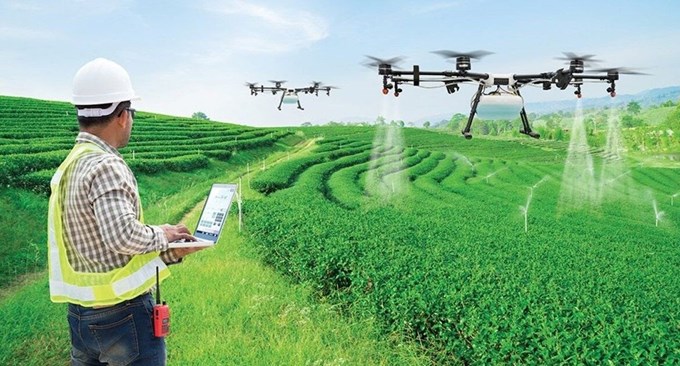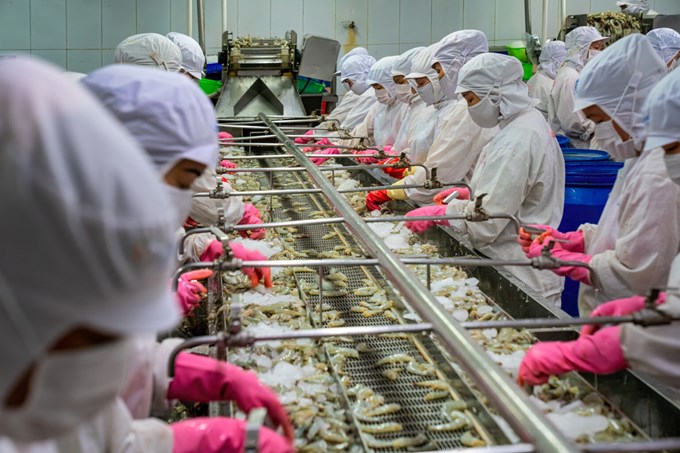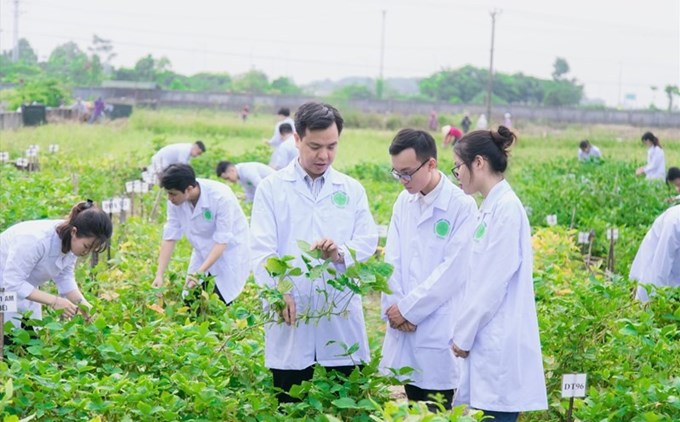It appears that for many years, Vietnam has lacked realistic strategies and for agricultural development that is commensurate with the demands of the new era.

Illustration photo. Source: the internet
Vietnam is an agricultural country, yet the sector is riddled with various paradoxes: The country ranks among the top in the world for exporting raw agricultural products — third in rice, second in coffee, pepper, and cashew, and fourth in seafood exports — but about 80% are exported in raw form at low prices. Farmers are diligent and intelligent, yet they are among the poorest and most disadvantaged in society1. Agriculture contributes about 11% of GDP but accounts for 26% of the workforce, showing extremely low labor productivity. Over 70% of the agricultural workforce has no formal training, making it hard to adopt advanced technologies. The capacity of agricultural scientists is underutilized due to ineffective management mechanisms2.
It seems that for many years, Vietnam has not had any strategy or plan truly feasible enough to develop an agriculture sector that is on par with the demands of the era. Trendy terms such as precision agriculture, smart agriculture, high-tech agriculture, circular agriculture, and ecological agriculture, etc. mostly exist on paper or in speeches, rather than in practice. Vietnam has become a major exporter of raw agricultural products, but not of branded, value-added goods. The agricultural sector is quantity-driven rather than quality-driven. As a result, despite great effort, returns remain low. Vietnamese agriculture functions as a “hired laborer” in other countries’ agricultural ecosystems, lacking pricing power in global value and supply chains — which leads to low profits and persistent vulnerability.
Changing Mindsets about Agriculture
It seems that we have not yet dared to embrace a “big dream”, and thus lack the great aspiration needed to develop a strategic vision and feasible plan for building a modern agricultural sector. To be fair, agriculture has not received adequate attention. The proportion of public investment in agriculture remains very low—rarely exceeding 5% of total investment capital, which is disproportionate to agriculture’s contribution to the national economy. Among the 11 groups of strategic technologies, few are directed toward agricultural development; most appear aimed at other objectives. Even a draft government decree on scholarships for fundamental sciences, core engineering, and strategic technologies makes no mention of agriculture, raising a crucial question: Is agricultural science and technology not considered “fundamental,” “core,” or “strategic” in Vietnam?

Vietnam ranks fourth in the world in seafood exports, but its exports are primarily concentrated in the low-price segment.
Not only has state capital been limited in agriculture, but private capital has also scarcely been invested in this sector. Instead, these vast financial resources often flow into land, real estate, gold, or foreign currencies, or simply remain idle in people’s pockets waiting for opportunities. However, the profits gained from fluctuations in land, gold, or currency prices do not generate any real added value for society—the same plot of land, the same house, the same bar of gold merely changes hands without creating new products. The state should restructure public investment to ensure fairer allocation to agriculture, while also implementing appropriate policies to channel private wealth and savings into agricultural development.
Agriculture has received little investment, perhaps because our starting point in agriculture in particular—and the economy as a whole—was very low. Having enough to eat was once considered a blessing; and when we managed to secure enough rice and sweet potatoes, exporting raw agricultural products to earn foreign currency became a source of pride. Moreover, when looking at developed countries, we tend to see only their industries and services, and thus believe that those must be our “spearhead” sectors. In the past, we pursued heavy industry, then shipbuilding, and now semiconductors, AI, and blockchain technology. There is a prevailing notion that one cannot become wealthy through agriculture.
Experience from countries with highly developed agricultural sectors shows that farming does not mean poverty. If one has the capacity to participate fully and play a decisive role in determining their own position—leading national and global agricultural value chains—agriculture can be a source of wealth. Agriculture is also an industry—indeed, not just an ordinary industry, but a high-tech industry (Hi-Tech Agro-Industry). It is where the latest achievements of the Fourth Industrial Revolution are applied, where financialization is strong, where all processes are digitized, and where products are created according to global standards. That is why one hectare of farmland in the Netherlands can generate from USD 100,000 to several million in value each year, while in Vietnam it averages only a few tens of millions of VND. Although there are a few models that produce billions of VND per hectare annually, they are very small in scale and difficult to replicate. Such a vast difference does not stem from poor soil or a lack of capable people, but rather from differences in strategic thinking and organizational approaches. The key question is “Do the state, the people, and businesses truly regard agriculture as a high-tech industry?”.
It is necessary to transform eight million smallholder farming households into farm owners capable of integrating into global agricultural value chains—becoming the “knowledgeable young farmers” of the 4.0 era—and thereby professionalizing agricultural production.
If agriculture is merely about crops and livestock relying on the “grace of Heaven,” then agriculture would remain the same as it was hundreds or even thousands of years ago—just villages and rice fields—altered only slightly by changes in climate, tools, and production methods. However, if agriculture involves the processing and deep processing of agricultural products, it becomes an agro-industry. If agriculture encompasses medicinal plants, pharmaceuticals, functional foods, and enhancing human health, it can create virtually limitless opportunities for wealth creation. If agriculture is viewed as tourism, as a lifestyle, as a way to nurture human character and foster harmony and reverence for Mother Nature, then agriculture becomes an integral part of civilized life, intertwined with essential spiritual values. Vietnam must no longer allow its competitive agricultural products such as coffee, pangasius, and pepper to remain mere raw materials for foreign brands. There must be a long-term national branding strategy, similar to how Japan has branded its fruits and beef, Norway its salmon, France its cheese, Italy its wine, Belgium its chocolate, and Switzerland its coffee. To illustrate, 1 kg of Vietnamese coffee beans sells for about USD 1.5, while 1 gram of Swiss ground coffee sells for about USD 25. Likewise, 1 kg of Vietnamese pangasius fillet sells for about 30,000–50,000 VND, whereas 1 kg of Norwegian salmon sells for 600,000–700,000 VND, and is consistently featured in five-star hotels, lavish banquets, and the daily meals of the upper class.
It is also worth briefly highlighting two of the “four pillar” resolutions: (i) Resolution No. 59-NQ/TW (dated January 24, 2025) on international integration in the new context. It may be time for Vietnam to consider establishing and developing an “agricultural diplomacy” strategy. There are numerous lessons to be learned from other countries in this regard. Agricultural diplomacy could enhance Vietnam’s strength on the international stage, supporting both bilateral and multilateral cooperation. We have often heard about the “soybean wars” and “sugar wars,” and we should also draw necessary lessons from the Covid-19 catastrophe and the current rice crisis in Japan; (ii) Resolution No. 66-NQ/TW on reforming the development and enforcement of laws to meet the demands of national development in the new era. Vietnam needs a coherent legal system that ensures unity from top to bottom and smooth coordination across all sectors, thereby creating the most favorable conditions for building a modern and internationally integrated agricultural sector. This should start with a comprehensive and well-aligned policy framework to attract investment at an appropriate scale, focusing on key agricultural industries, and a sincere talent attraction policy to recruit highly skilled and capable individuals—treating this as a core policy for agricultural development.
Promoting Scientific and Technological Application in Agriculture
While emerging technologies such as AI, IoT, and blockchain are important, they must serve the needs of agriculture. Ultimately, the development of cutting-edge 4.0 technologies must be directed toward serving agriculture—so that Vietnamese agriculture can, like that of the United States, the Netherlands, Australia, and Israel, generate substantial wealth, enhance the country’s international standing, and build its global reputation. The recently issued Resolution 57 on Science, Technology, Innovation, and Digital Transformation—perhaps inspired by the spirit of Khoán 10 (Contract 10) —offers an opportunity to accelerate this transformation. For example, digital platforms can directly connect Vietnamese agriculture to international markets, while AI and big data can optimize supply chain operations, enabling farmers to connect directly with customers without relying on intermediaries. After all, agriculture is the foundation, the comparative advantage, and the inherent strength of Vietnam. While it is important to pursue ambitious and forward-looking sectors, we must not forget our roots. If Vietnam can bring its agriculture to the front line of the global agricultural value chain, then Vietnamese-made technologies and products will also have the opportunity to affirm Vietnam’s position in the global marketplace.

Students during a practical session at Vietnam National University of Agriculture.
Photo: Thieu Trang / Lao Động Newspaper.
Alongside cutting-edge technologies such as AI, the IoT, and blockchain, etc., traditional technologies including processing, preservation, and cold-chain logistics are also critically important. These serve as the foundation for Vietnam to develop national agricultural logistics hubs that can maintain product quality, meet international standards, increase the proportion of deeply processed agricultural products, and promote products with labeling and branding.
To accelerate the translation of research into practice, Vietnam needs to create a favorable environment for the development of agricultural and food technology startups (AgriTech and FoodTech). One immediate priority is to promote the use of technologies for food traceability and source transparency. Beyond that, it is essential to build agricultural innovation ecosystems that integrate AgriTech, FoodTech, and FinTech, thereby connecting all components of the value chain—from research and production to distribution and consumption. Such ecosystems would provide an open environment for piloting and scaling up new technological solutions.
More importantly, to be able to adopt and apply new technologies, Vietnam must develop a high-quality human resource base in line with the spirit of Resolution 71-NQ/TW (dated August 22, 2025) of the Politburo on breakthrough reforms in education and training. The goal is that one day, Vietnam will be able to export agricultural technologies and experts—just as it now exports unskilled labor. However, this must go hand in hand with training for farmers—indeed, special attention should be given to farmers. A term frequently used in recent years is the “intellectualization of farmers,” meaning equipping them with the knowledge and capacity to address their own challenges. This includes the ability to use modern machinery and advanced technologies, and to apply digitization, automation, and electronic systems in production, management, distribution, and commerce. Vietnam must transform its eight million smallholder households into farm owners capable of integrating into global agricultural value chains—becoming “knowledgeable farmers” of the Industry 4.0 era—and thereby professionalize agricultural production. Farming should be recognized as a profession that requires formal training, as well as knowledge and skills in diverse fields—from science and technology to markets. It is a noble and respectable profession, one that should be considered as “modern” and “prestigious” as any other profession in society.
Empowering the Private Sector to Lead Vietnamese Agriculture
The private sector, with its dynamism, creativity, and strong adaptability, has been investing heavily in agriculture across all stages of the agricultural value chain — from production, processing, and preservation to distribution and export. Many private enterprises have taken the lead in applying high technologies, developing organic agriculture, and adopting smart farming practices. This sector also commercializes research more rapidly, flexibly, practically, and effectively than the state sector. For example, Ha Quang Company, founded by Labor Hero Ho Quang Cua, created rice varieties ranked among the best in the world without any state funding. TH True Milk Group has imported high-yield dairy cattle genetics from New Zealand and implemented AI-based farm management systems. Similarly, Dabaco and Anova Groups have invested in modern laboratories to breed drought- and pest-resistant varieties, while TTC AgriS has pioneered the full digitalization of its production and management systems. These are highly convincing examples of private-sector innovation driving agricultural development.
A strong commitment from the government is essential to shift from a production-oriented agricultural mindset to an agriculture-based economic mindset.
Private enterprises have been the earliest to recognize the potential, advantages, and profitability of smart, sustainable, and branded agriculture. They contribute to increasing the added value of Vietnamese agricultural products through deep processing, brand development, and market expansion. These enterprises actively seek partners, meet the stringent standards of international markets, and play a leading role in agricultural exports. An increasing number of organic agricultural models—such as Vinamit, Tâm Thao, and Biogreen, etc.—have achieved rigorous certifications including USDA Organic, EU Organic, and Global GAP. The USD 62.5 billion in agricultural export revenue recorded last year was largely driven by private enterprises. In a personal discussion with the author, former Minister of Agriculture Cao Duc Phat noted that for export products, farmers receive up to 70% of the product’s value, significantly higher than in most other sectors.
It can be said that Vietnamese enterprises will serve as the pioneering force in restructuring the country’s agriculture—transforming it from a “hired labor” model into an active owner on the international stage. They will reshape Vietnam’s agricultural value chains toward sustainability through innovation and digital transformation, developing smart farms, warehouse management systems, cold-chain logistics, e-commerce platforms for agriculture, digital supply chain management systems, and technology-based traceability to manage the entire value chain from production to distribution. However, achieving this requires strong government commitment to shift from a production-oriented mindset to an agriculture-based economic mindset. The government should encourage leading enterprises in the value chain to break away from fragmented, small-scale production—acting as both the driving force and the pulling force to develop raw material zones that are sufficiently large in scale, and strong in infrastructure, logistics, and processing capacity. The State can also promote the development of modern cooperatives, where farmers retain land ownership but participate in value chains through standardized contracts, while receiving support in capital, breeding stock, techniques, technology, and market access.
To empower agricultural enterprises and cooperatives, the State must allow large-scale land accumulation for high-tech agricultural production. At the same time, Vietnam must expand the rights to transfer, mortgage, and contribute capital using land-use rights, while safeguarding the interests of vulnerable groups, unlocking resources, and attracting long-term investment. Although agriculture can generate wealth, investment in this sector must be long-term and sustainable, rather than driven by short-term profit motives. Therefore, it is essential to establish a legal framework for the financialization of agriculture — including the development of agricultural insurance, mechanisms for risk-sharing among the State, enterprises, farmers, research institutions, rural credit funds, agricultural bonds, and agricultural commodity exchanges — so that financial flows can enter agriculture in a structured and systematic manner.
To conclude this article, let us recall President Ho Chi Minh’s Letter to Vietnamese Landlords and Farmers dated April 11, 1946, in which he affirmed an enduring truth about the nation’s development:
“If our farmers are rich, our country will be rich. If our agriculture thrives, our country will thrive.”
——–
Footnotes
1 https://www.tapchicongsan.org.vn/media-story/-/asset_publisher/V8hhp4dK31Gf/content/nghi-quyet-ve-nong-nghiep-nong-dan-nong-thon-va-vi-the-cua-nguoi-nong-dan
2 https://nongnghiepmoitruong.vn/khoa-hoc-giai-quyet-van-de-lon-cua-dat-nuoc-chu-khong-phai-noi-dung-dang-dung-de-d238829.html
Published in Tia Sáng Magazine Issue No. 17/2025
Prof. Tran Duc Vien, Former President of Vietnam National University of Agriculture